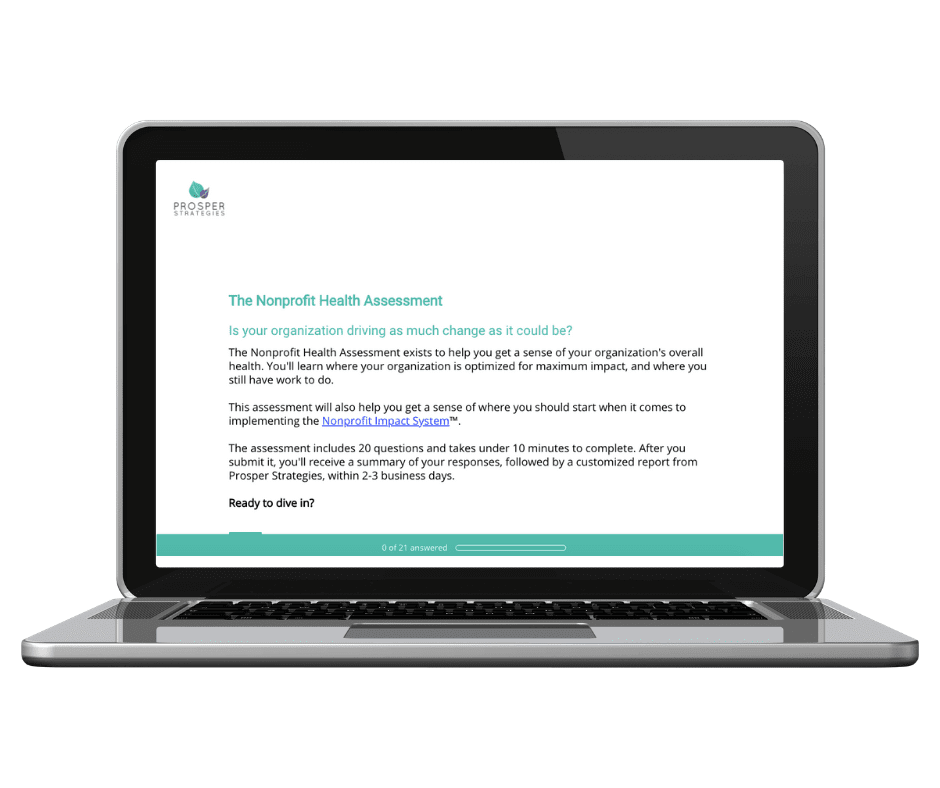Since we introduced The Nonprofit Strategy System™ in April 2020, you’ve seen it on our website, we’ve written about it over the course of the year, and now you’re asking, how can I use the system at my organization to make our nonprofit more effective? Here, we’re reviewing the system and providing indicators to help you determine if your organization is on the path to Nonprofit Strategy System success.
The Nonprofit Strategy System™ has four elements, Focus, Strategy, People and Progress, and it’s deliberately set up in a pyramid structure. Each element builds toward the next.
FOCUS
It starts with Focus. Successful nonprofits are clear about their mission and vision, they’ve achieved internal alignment with the help of core values and their internal alignment is reflected consistently externally through their brand and communications. While focused nonprofits have clear messaging, they’re also well-differentiated from others in their space, with a clear reason for being.
Organizations that have mastered the Focus element:
- Have stronger brand awareness and brand affinity, which manifests in strong community partnerships
- Can clearly communicate their mission and impact to those who matter most to their organization
- Have the ability to raise more funds
STRATEGY
The next element of The Nonprofit Strategy System™ is Strategy. While most nonprofits know they need a strategic plan, many either don’t have one or have one but it is out of date or rarely referenced. Forward-thinking nonprofits think about strategic planning as an ongoing process. The document exists for reference, but strategic decisions are being evaluated and made regularly.
In addition to having well-documented but agile strategic plans, the most successful nonprofits also have detailed plans for each one of their programs, as well as marketing and fundraising plans.
Organizations that have mastered the Strategy element are:
- Proactive rather than reactive
- Because they have plans in place, they are always looking to the future
- Less overwhelmed because their priorities are clear
- More effective because everyone is rowing in the same direction toward the same important goals
PEOPLE
The People element of The Nonprofit Strategy System™ is the linchpin for successful organizations. Nonprofits that find a way to get the right people to do the right things at the right time are unstoppable. This starts with a nonprofit’s leadership team and carries over to staff. It’s propelled by a strong board of directors that supports the organization’s vision and strategy for getting there. Most importantly, it’s guided by insights from a nonprofit’s stakeholders, including those it serves.
[bctt tweet=”Nonprofits that find a way to get the right people to do the right things at the right time are unstoppable.” username=”ProsperStrat”]Organizations that have mastered the People element:
- Are responsive to their stakeholders’ needs
- Have the right people in the right seats to maximize impact
- Demonstrate diversity, equity and inclusion practices with their team, board and actions
- Have strong board/staff relationships
PROGRESS
Finally, The Nonprofit Strategy System’s™ Progress element brings everything together. Even with a clear focus, smart strategies, and the right people in the right roles, it can be hard to get everyone on your team to take consistent, coordinated action to advance your mission. The Progress element solves this problem by building a culture of accountability and putting processes in place that keep everyone on track.
Organizations that have mastered the Progress element:
- Are clear about what success looks like at their nonprofit
- Are financially healthy and sustainable
- Are transparent about their successes and their failures
- Measure outcomes over outputs
If you’re ready to put The Nonprofit Strategy System™ to work for your nonprofit in 2021, start today by taking The Nonprofit Health Assessment to identify areas where your organization is strong and where you need improvement.

